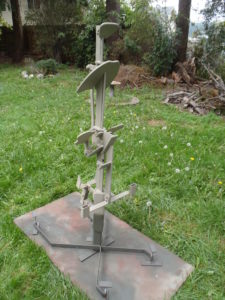
What makes the KTAK different?
To put it as simply as I can, it is a multiple hit, multiple reaction close range training system. There just isn’t another target on the market that does what this one does.
How hard is it to put together?
Very easy as there are only a few tools required. And the assembly is just putting the base together and installing the crossbar. This allows me to put it into a smaller crate for shipping.
Once the base is assembled. All you have to do is put the base on the ground, slide the pillar into the base then slide the upper torso in place. Last step is to bolt on the crossbar.
Follow the simple set up and adjustment directions that come with it and you are good to go.
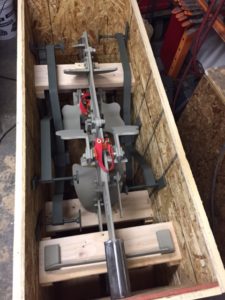
Can I shoot it with different calibers?
Absolutely, just adjust the linkage on the target so it falls with the chosen number of rounds depending on the caliber of your weapon. Smaller calibers take a lighter setting of the knockdown mechanism.
And it can be shot with lighter calibers even when it is set for heavier ones. Lighter rounds will still knock it down, it will just take more of them. For example, when set to take multiple hits from a 45 ACP, it will take approximately double the number of 9mm to achieve the same result.
But generally a single hit to the head plate will take it down no matter how the target is set.
Nor do you need to make changes to the set up when transitioning between a long gun and a side arm. Works equally well with both.
How does it regulate the number of rounds?
Simple physics. There are no fancy electronics to maintain nor does it require any battery or electrical power or air system. Just a simple mechanism adjusted with 2 standard 9/16th’s wrenches.
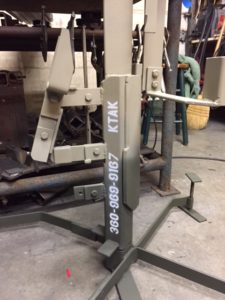
Can I shoot it with a rifle or carbine? How about a shotgun?
Yes. The rifle/carbine capable version (better known as the RPS model) is built of hardened plate so yes it obviously can take hits from a rifle/carbine.
The target is made to accept hits from .223/5.56, 300 Blackout (sub and supersonic) 7.62 x 39mm, 6.8 SPC and 7.62x40WT. Just remember no steel or tungsten core rounds.
For testing purposes it was also hit with about 40 rounds of .308. But this round is just a bit too destructive for continuous use. But I have made some changes that may allow .308 use on the chest plate, call me for the latest on this.
Any of the targets can be hit with buckshot from a shotgun.
I still have to do some testing with slugs from a shotgun even though it has been hit with 44 Mag that fired a round almost as heavy as a shotgun slug without damage to the target or shooter (me).
What about Frangible rounds?
Learned a few things about frangible ammo in a recent test session at the range. The particular stuff I bought had the exact same effect on the target as FMJ rounds. This was 45 ACP and 223 rounds.
Frangible pistol rounds can be used on any of my targets but frangible rifle can only be used on a hardened target.
I have also learned that frangible ammo is harder on the target than traditional FMJ rounds. While they do come apart after they hit the plates, that initial impact of the round does more damage to the steel. Mainly because there is no soft material in frangible rounds.
Can it be shot when you are not directly in front of it?
Yes, during testing I shot it at extreme angles. With a pistol you can move almost 30 degrees off centerline and the target still functions as designed. Giving you about a 60 degree zone to effectively engage the target. Just be aware that deflections are now going in another direction, much further to the side.
If you do want to move off centerline the target must be in a bay that has berms to the sides to keep deflections within the range area
I recently made a change to the RPS model that allows it to be shot at off center. Testing has shown that you can hit the chest and head plates as far off center as when using a pistol. Giving you that same 60 degree cone to engage the target.
But do restrict shots to the hip plates from a rifle at about a 10 degree cone due to how the armor is constructed around the pivoting parts of the target. When using a pistol the hip plates do not have this same restriction.
Also restrict hip shots to 10 yards or further due to possible deflections from the non impact areas that protect the functioning parts of the target.
Do I have to use t-shirts and cardboard?
The target was designed to be used while covered. Shooting it without a shirt or cardboard somewhat defeats the benefit of this system. Additionally the cardboard, stakes and shirt all contribute to the function of the target so leaving them off will require adjustments to the system….
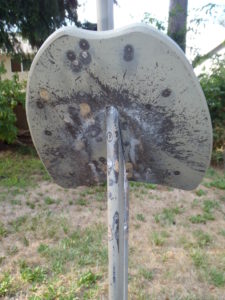
What about deflections?
Design of my targets focuses the deflections to the ground just behind the target or slightly to the side. There are minimal surfaces that face the shooter.
Everything is angled to keep rounds from coming back at the shooter, which is not uncommon with standard flat plates and poppers that most folks are used to shooting at.
The KTAK target minimizes splashback but always follow standard safety considerations when shooting steel. Safety glasses, long pants and sleeves and a safe distance.
How close can I shoot it from?
This is the area that scares the lawyers. And on a certain level, me as well. The target has been designed to be as safe as possible. But you must realize it is made of steel…. And as such it must be treated with care and respect.
If you do your research you will find there is a broad range of minimum distances suggested by various sources. For pistol, this can vary from 23 feet (USPSA rules), 10 yds (IDPA rules), 15 yds (one of the target manufacturers) and for rifle the shortest number I have seen is 50 yards on an angled strike plate but most of the time it is 100 yards or more, according to the big target manufacturers.
But all of these are when shooting at traditional flat steel, nothing at all like my target….
So what is a safe distance? There are factors involved that are beyond my control, mainly the surface the target sits on, what it is being shot with (caliber and bullet type) and just who is shooting at it.
What I can say is that I have seen my targets fired at from extremely close distances but I would suggest you start with a much more traditional minimum distance when using a pistol. Rifle use is where things get interesting as all of the testing has been done at extremely close ranges….
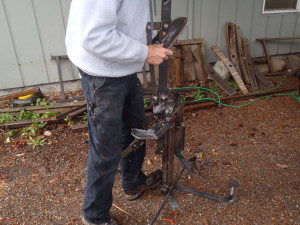
Is it difficult to set up or re-set after it has been knocked down?
Not at all. Set up is very simple and clearly explained in the operation manual that I wrote. Re-set is even easier, just lift up and make sure a few parts are back in place. Usually takes longer to knock it over than to re-set it.
How often does it need to be adjusted?
There is an initial break in of about 100 hits as all the parts get worn in together. But all you will have to do is tighten the bolts a bit as they loosen up during this short break in.
After this initial period if you only shoot one caliber, adjustments don’t have to be made very often at all. It will hold it’s settings for hundreds, even thousands of hits.
If you use a lot of different calibers you will want to make adjustments more often.
How much does it weigh?
The KTAK RPS model weighs 109 lbs.
How tall is it?
When reset ready to shoot, it is approximately 65in high at the top of the head plate (Cardboard and a paper face will be just under 6ft).
Height was chosen to make it a touch safer in front of a berm, helps keep the rounds in the range when you miss the strike plates.
Does it require a lot of maintenance?
No, some occasional spray paint to keep the rust at bay and a bit of lube (I use Kroil or WD40) on the pivots from time to time should be all you need. Avoid heavier oils as they make things too slick.
Replacement parts?

Being that it is a chassis based system, only select parts will ever need replacement and those are readily available, the strike plates and some of the armor rods are basically the only parts to take significant wear.
And all strike plates as well as the armor is replaceable without any user welding required, the new part just bolts on. The stake pocket cross bar is also a bolt on part.
Mostly this concerns the rifle version of the target as it takes far more abuse but if all you use is the recommended pistol rounds and buckshot you are not likely to ever need to replace the strike plates.
